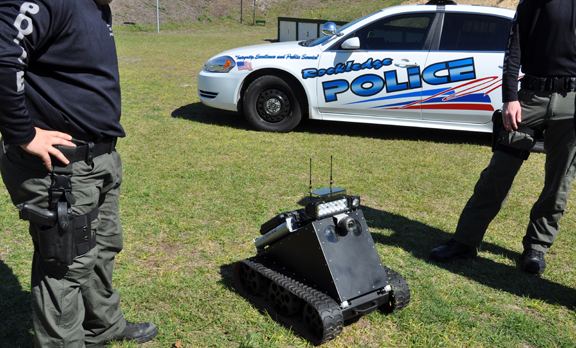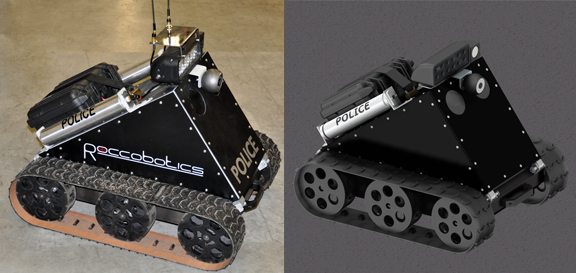Latest News
March 17, 2011


 When Detective Christopher Cochie from Rockledge Police Department, Florida, first approached FIRST Robotic Competition (FRC) Team 233 to help build a robot for his SWAT team, he had something fairly simple in mind, like a remote-controlled miniature car with a camera mounted on the hood. The team took his ideas, added some of their own, and came back to him instead with a state-of-the-art robot that could climb up steps, trudge through mud, toss a phone, launch flash bangs, and do much more.
When Detective Christopher Cochie from Rockledge Police Department, Florida, first approached FIRST Robotic Competition (FRC) Team 233 to help build a robot for his SWAT team, he had something fairly simple in mind, like a remote-controlled miniature car with a camera mounted on the hood. The team took his ideas, added some of their own, and came back to him instead with a state-of-the-art robot that could climb up steps, trudge through mud, toss a phone, launch flash bangs, and do much more.
Its creators, a group of students from FRC Team 233, were well-versed in the mechanics of robotics, thanks to the competitions they’d participated in. Given the chance to help their local police officers, they jumped at the opportunity, enlisting the help of their teacher and FIRST mentor Marian Passmore and their FIRST sponsor NASA. (Team members were mostly from the Cocoa Beach area, roughly 15 miles away from Cape Canaveral and the Kennedy Space Center.)
Though it weighs approximately 100 LBs, PDBot is designed so it can be transported by a single person. It has pneumatic canister launchers, for both short- and long-range targets. It’s equipped with a camera, capable of video recording. Its chassis can withstand heat and moisture; its tank-style wheels can move along inclines and vegetation—design features for conquering Florida’s swampy terrain. In field tests, the robot proves strong enough to drag a human with little or no effort. Using its microphone, it can literally talk to a suspect.
Officers may deploy it in crisis situations, for instance, to open up a communication line for hostage negotiation or to distract a hostile suspect. With PDBot providing sight and sound, officers can remotely inspect and assess dangerous environments without compromising their safety. Most likely PDBot will ride alongside SWAT officers when they respond to calls.
Charlie Stankie, one of the students responsible for producing CAD designs for the team, recalled, “[The police department] was even thinking about going to Walmart and buying a remote-controlled car to tow the throw-phone out to the target [a common approach in hostage negotiation] ... Over time, imagination led to something substantially more complicated and quite a bit bigger.”
Charlie and his team uses PTC‘s Pro/ENGINEER CAD software (recently renamed Creo Elements/Pro) to design their competition robots. Naturally, they relied on the same package to develop the PDBot. “We built the entire model with all the parts, down to the bolts,” he recalled. “Mainly we did it for spacing, to figure out how we’d have to arrange everything so they would all fit, because it’s a relatively compact package.”
The students also used Pro/ENGINEER to verify clearance among the robot’s moving parts, using the software’s basic mechanical simulation tools.
Kaitlin Lostroscio, the pit crew chief for the team, said, “There’s nothing like [PDBot] out there. Ours is entirely unique. Many other robots would just have a camera ... With our long design process, we were able to actually figure out everything beforehand ... Now it’s just a matter of working out a few [system] communication issues here and there so that they can get the best distance with it. We don’t want them to have any interferences.”
Though her post-high school aspirations are still up in the air, Kaitlin said, “I know I definitely want to be involved in robotics in one way or another ... Biomedical engineering, something like the PDBot—that’s a field of its own, when you think of it, or Mars robot—The list goes on.”
Team 233 proudly wears the moniker The Pink Team. They also wear the team’s color on competition days. Most are content to show their allegiance via a pink t-shirt, but some—both boys and girls—go as far as dying their hair pink. The nickname, as it turned out, was an object lesson in collaboration—particularly, about the importance of group decisions,
“Years ago, at the beginning of it all, they were having a team meeting, deciding the motto, the team color, the mascot, everything like that,” explained Kaitlin. “The guys decided to just leave that to the girls. They didn’t show up to the meeting. So the girls decided, Hey, we’re gonna call it The Pink Team.”
Detective Cochie, who has been on the force for six years and a SWAT officer for four, said, “This project is the best thing I’ve ever been involved in in my career so far. It’s given me pride for my job, pride in my community ... The students gave us something that will eventually save the life of one of us.”
FRC 233: The Pink Team keeps a home page here.
More information about the team’s SWAT robot can be found at http://www.roccobotics.com.
You can find more videos from the team at their YouTube channel.
For more, listen to the podcasts with Kaitlin and Charlie below and watch the video clip of the PDBot in action.


Subscribe to our FREE magazine, FREE email newsletters or both!
Latest News
About the Author
Kenneth Wong is Digital Engineering’s resident blogger and senior editor. Email him at [email protected] or share your thoughts on this article at digitaleng.news/facebook.
Follow DE





